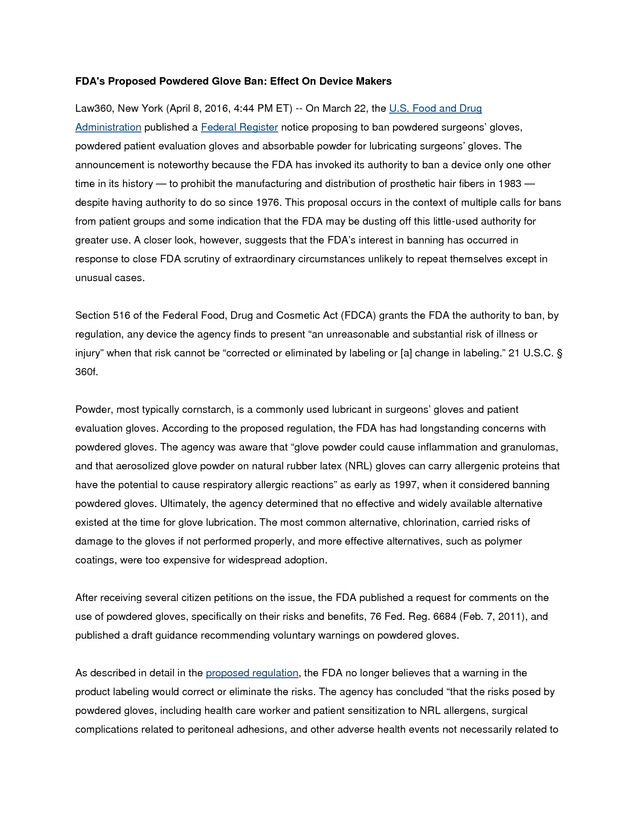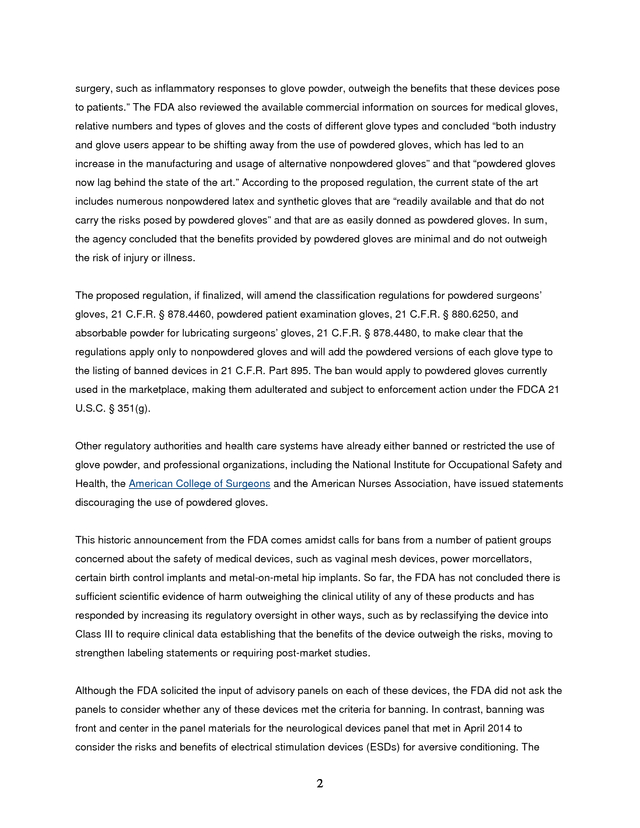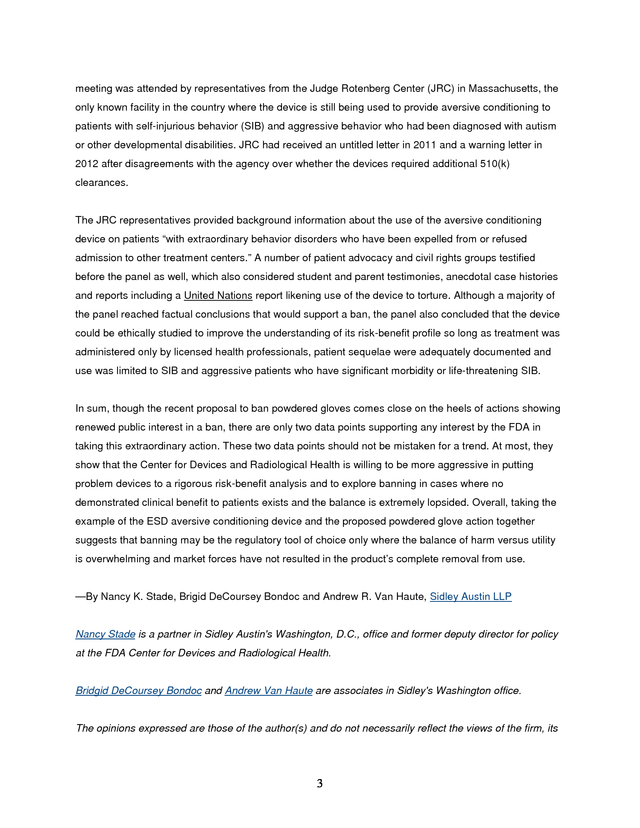Description
FDA's Proposed Powdered Glove Ban: Effect On Device Makers
Law360, New York (April 8, 2016, 4:44 PM ET) -- On March 22, the U.S. Food and Drug
Administration published a Federal Register notice proposing to ban powdered surgeons’ gloves,
powdered patient evaluation gloves and absorbable powder for lubricating surgeons’ gloves. The
announcement is noteworthy because the FDA has invoked its authority to ban a device only one other
time in its history — to prohibit the manufacturing and distribution of prosthetic hair fibers in 1983 —
despite having authority to do so since 1976. This proposal occurs in the context of multiple calls for bans
from patient groups and some indication that the FDA may be dusting off this little-used authority for
greater use.
A closer look, however, suggests that the FDA’s interest in banning has occurred in response to close FDA scrutiny of extraordinary circumstances unlikely to repeat themselves except in unusual cases. Section 516 of the Federal Food, Drug and Cosmetic Act (FDCA) grants the FDA the authority to ban, by regulation, any device the agency finds to present “an unreasonable and substantial risk of illness or injury” when that risk cannot be “corrected or eliminated by labeling or [a] change in labeling.” 21 U.S.C. § 360f. Powder, most typically cornstarch, is a commonly used lubricant in surgeons’ gloves and patient evaluation gloves. According to the proposed regulation, the FDA has had longstanding concerns with powdered gloves.
The agency was aware that “glove powder could cause inflammation and granulomas, and that aerosolized glove powder on natural rubber latex (NRL) gloves can carry allergenic proteins that have the potential to cause respiratory allergic reactions” as early as 1997, when it considered banning powdered gloves. Ultimately, the agency determined that no effective and widely available alternative existed at the time for glove lubrication. The most common alternative, chlorination, carried risks of damage to the gloves if not performed properly, and more effective alternatives, such as polymer coatings, were too expensive for widespread adoption. After receiving several citizen petitions on the issue, the FDA published a request for comments on the use of powdered gloves, specifically on their risks and benefits, 76 Fed.
Reg. 6684 (Feb. 7, 2011), and published a draft guidance recommending voluntary warnings on powdered gloves. As described in detail in the proposed regulation, the FDA no longer believes that a warning in the product labeling would correct or eliminate the risks.
The agency has concluded “that the risks posed by powdered gloves, including health care worker and patient sensitization to NRL allergens, surgical complications related to peritoneal adhesions, and other adverse health events not necessarily related to . surgery, such as inflammatory responses to glove powder, outweigh the benefits that these devices pose to patients.” The FDA also reviewed the available commercial information on sources for medical gloves, relative numbers and types of gloves and the costs of different glove types and concluded “both industry and glove users appear to be shifting away from the use of powdered gloves, which has led to an increase in the manufacturing and usage of alternative nonpowdered gloves” and that “powdered gloves now lag behind the state of the art.” According to the proposed regulation, the current state of the art includes numerous nonpowdered latex and synthetic gloves that are “readily available and that do not carry the risks posed by powdered gloves” and that are as easily donned as powdered gloves. In sum, the agency concluded that the benefits provided by powdered gloves are minimal and do not outweigh the risk of injury or illness. The proposed regulation, if finalized, will amend the classification regulations for powdered surgeons’ gloves, 21 C.F.R. § 878.4460, powdered patient examination gloves, 21 C.F.R. § 880.6250, and absorbable powder for lubricating surgeons’ gloves, 21 C.F.R.
§ 878.4480, to make clear that the regulations apply only to nonpowdered gloves and will add the powdered versions of each glove type to the listing of banned devices in 21 C.F.R. Part 895. The ban would apply to powdered gloves currently used in the marketplace, making them adulterated and subject to enforcement action under the FDCA 21 U.S.C.
§ 351(g). Other regulatory authorities and health care systems have already either banned or restricted the use of glove powder, and professional organizations, including the National Institute for Occupational Safety and Health, the American College of Surgeons and the American Nurses Association, have issued statements discouraging the use of powdered gloves. This historic announcement from the FDA comes amidst calls for bans from a number of patient groups concerned about the safety of medical devices, such as vaginal mesh devices, power morcellators, certain birth control implants and metal-on-metal hip implants. So far, the FDA has not concluded there is sufficient scientific evidence of harm outweighing the clinical utility of any of these products and has responded by increasing its regulatory oversight in other ways, such as by reclassifying the device into Class III to require clinical data establishing that the benefits of the device outweigh the risks, moving to strengthen labeling statements or requiring post-market studies. Although the FDA solicited the input of advisory panels on each of these devices, the FDA did not ask the panels to consider whether any of these devices met the criteria for banning. In contrast, banning was front and center in the panel materials for the neurological devices panel that met in April 2014 to consider the risks and benefits of electrical stimulation devices (ESDs) for aversive conditioning.
The 2 . meeting was attended by representatives from the Judge Rotenberg Center (JRC) in Massachusetts, the only known facility in the country where the device is still being used to provide aversive conditioning to patients with self-injurious behavior (SIB) and aggressive behavior who had been diagnosed with autism or other developmental disabilities. JRC had received an untitled letter in 2011 and a warning letter in 2012 after disagreements with the agency over whether the devices required additional 510(k) clearances. The JRC representatives provided background information about the use of the aversive conditioning device on patients “with extraordinary behavior disorders who have been expelled from or refused admission to other treatment centers.” A number of patient advocacy and civil rights groups testified before the panel as well, which also considered student and parent testimonies, anecdotal case histories and reports including a United Nations report likening use of the device to torture. Although a majority of the panel reached factual conclusions that would support a ban, the panel also concluded that the device could be ethically studied to improve the understanding of its risk-benefit profile so long as treatment was administered only by licensed health professionals, patient sequelae were adequately documented and use was limited to SIB and aggressive patients who have significant morbidity or life-threatening SIB. In sum, though the recent proposal to ban powdered gloves comes close on the heels of actions showing renewed public interest in a ban, there are only two data points supporting any interest by the FDA in taking this extraordinary action. These two data points should not be mistaken for a trend.
At most, they show that the Center for Devices and Radiological Health is willing to be more aggressive in putting problem devices to a rigorous risk-benefit analysis and to explore banning in cases where no demonstrated clinical benefit to patients exists and the balance is extremely lopsided. Overall, taking the example of the ESD aversive conditioning device and the proposed powdered glove action together suggests that banning may be the regulatory tool of choice only where the balance of harm versus utility is overwhelming and market forces have not resulted in the product’s complete removal from use. —By Nancy K. Stade, Brigid DeCoursey Bondoc and Andrew R.
Van Haute, Sidley Austin LLP Nancy Stade is a partner in Sidley Austin's Washington, D.C., office and former deputy director for policy at the FDA Center for Devices and Radiological Health. Bridgid DeCoursey Bondoc and Andrew Van Haute are associates in Sidley's Washington office. The opinions expressed are those of the author(s) and do not necessarily reflect the views of the firm, its 3 . clients, or Portfolio Media Inc., or any of its or their respective affiliates. This article is for general information purposes and is not intended to be and should not be taken as legal advice. All Content © 2003-2016, Portfolio Media, Inc. 4 .
A closer look, however, suggests that the FDA’s interest in banning has occurred in response to close FDA scrutiny of extraordinary circumstances unlikely to repeat themselves except in unusual cases. Section 516 of the Federal Food, Drug and Cosmetic Act (FDCA) grants the FDA the authority to ban, by regulation, any device the agency finds to present “an unreasonable and substantial risk of illness or injury” when that risk cannot be “corrected or eliminated by labeling or [a] change in labeling.” 21 U.S.C. § 360f. Powder, most typically cornstarch, is a commonly used lubricant in surgeons’ gloves and patient evaluation gloves. According to the proposed regulation, the FDA has had longstanding concerns with powdered gloves.
The agency was aware that “glove powder could cause inflammation and granulomas, and that aerosolized glove powder on natural rubber latex (NRL) gloves can carry allergenic proteins that have the potential to cause respiratory allergic reactions” as early as 1997, when it considered banning powdered gloves. Ultimately, the agency determined that no effective and widely available alternative existed at the time for glove lubrication. The most common alternative, chlorination, carried risks of damage to the gloves if not performed properly, and more effective alternatives, such as polymer coatings, were too expensive for widespread adoption. After receiving several citizen petitions on the issue, the FDA published a request for comments on the use of powdered gloves, specifically on their risks and benefits, 76 Fed.
Reg. 6684 (Feb. 7, 2011), and published a draft guidance recommending voluntary warnings on powdered gloves. As described in detail in the proposed regulation, the FDA no longer believes that a warning in the product labeling would correct or eliminate the risks.
The agency has concluded “that the risks posed by powdered gloves, including health care worker and patient sensitization to NRL allergens, surgical complications related to peritoneal adhesions, and other adverse health events not necessarily related to . surgery, such as inflammatory responses to glove powder, outweigh the benefits that these devices pose to patients.” The FDA also reviewed the available commercial information on sources for medical gloves, relative numbers and types of gloves and the costs of different glove types and concluded “both industry and glove users appear to be shifting away from the use of powdered gloves, which has led to an increase in the manufacturing and usage of alternative nonpowdered gloves” and that “powdered gloves now lag behind the state of the art.” According to the proposed regulation, the current state of the art includes numerous nonpowdered latex and synthetic gloves that are “readily available and that do not carry the risks posed by powdered gloves” and that are as easily donned as powdered gloves. In sum, the agency concluded that the benefits provided by powdered gloves are minimal and do not outweigh the risk of injury or illness. The proposed regulation, if finalized, will amend the classification regulations for powdered surgeons’ gloves, 21 C.F.R. § 878.4460, powdered patient examination gloves, 21 C.F.R. § 880.6250, and absorbable powder for lubricating surgeons’ gloves, 21 C.F.R.
§ 878.4480, to make clear that the regulations apply only to nonpowdered gloves and will add the powdered versions of each glove type to the listing of banned devices in 21 C.F.R. Part 895. The ban would apply to powdered gloves currently used in the marketplace, making them adulterated and subject to enforcement action under the FDCA 21 U.S.C.
§ 351(g). Other regulatory authorities and health care systems have already either banned or restricted the use of glove powder, and professional organizations, including the National Institute for Occupational Safety and Health, the American College of Surgeons and the American Nurses Association, have issued statements discouraging the use of powdered gloves. This historic announcement from the FDA comes amidst calls for bans from a number of patient groups concerned about the safety of medical devices, such as vaginal mesh devices, power morcellators, certain birth control implants and metal-on-metal hip implants. So far, the FDA has not concluded there is sufficient scientific evidence of harm outweighing the clinical utility of any of these products and has responded by increasing its regulatory oversight in other ways, such as by reclassifying the device into Class III to require clinical data establishing that the benefits of the device outweigh the risks, moving to strengthen labeling statements or requiring post-market studies. Although the FDA solicited the input of advisory panels on each of these devices, the FDA did not ask the panels to consider whether any of these devices met the criteria for banning. In contrast, banning was front and center in the panel materials for the neurological devices panel that met in April 2014 to consider the risks and benefits of electrical stimulation devices (ESDs) for aversive conditioning.
The 2 . meeting was attended by representatives from the Judge Rotenberg Center (JRC) in Massachusetts, the only known facility in the country where the device is still being used to provide aversive conditioning to patients with self-injurious behavior (SIB) and aggressive behavior who had been diagnosed with autism or other developmental disabilities. JRC had received an untitled letter in 2011 and a warning letter in 2012 after disagreements with the agency over whether the devices required additional 510(k) clearances. The JRC representatives provided background information about the use of the aversive conditioning device on patients “with extraordinary behavior disorders who have been expelled from or refused admission to other treatment centers.” A number of patient advocacy and civil rights groups testified before the panel as well, which also considered student and parent testimonies, anecdotal case histories and reports including a United Nations report likening use of the device to torture. Although a majority of the panel reached factual conclusions that would support a ban, the panel also concluded that the device could be ethically studied to improve the understanding of its risk-benefit profile so long as treatment was administered only by licensed health professionals, patient sequelae were adequately documented and use was limited to SIB and aggressive patients who have significant morbidity or life-threatening SIB. In sum, though the recent proposal to ban powdered gloves comes close on the heels of actions showing renewed public interest in a ban, there are only two data points supporting any interest by the FDA in taking this extraordinary action. These two data points should not be mistaken for a trend.
At most, they show that the Center for Devices and Radiological Health is willing to be more aggressive in putting problem devices to a rigorous risk-benefit analysis and to explore banning in cases where no demonstrated clinical benefit to patients exists and the balance is extremely lopsided. Overall, taking the example of the ESD aversive conditioning device and the proposed powdered glove action together suggests that banning may be the regulatory tool of choice only where the balance of harm versus utility is overwhelming and market forces have not resulted in the product’s complete removal from use. —By Nancy K. Stade, Brigid DeCoursey Bondoc and Andrew R.
Van Haute, Sidley Austin LLP Nancy Stade is a partner in Sidley Austin's Washington, D.C., office and former deputy director for policy at the FDA Center for Devices and Radiological Health. Bridgid DeCoursey Bondoc and Andrew Van Haute are associates in Sidley's Washington office. The opinions expressed are those of the author(s) and do not necessarily reflect the views of the firm, its 3 . clients, or Portfolio Media Inc., or any of its or their respective affiliates. This article is for general information purposes and is not intended to be and should not be taken as legal advice. All Content © 2003-2016, Portfolio Media, Inc. 4 .

















